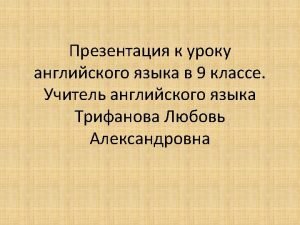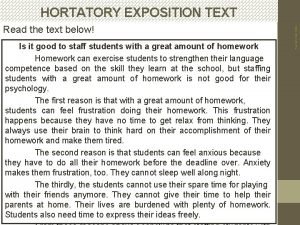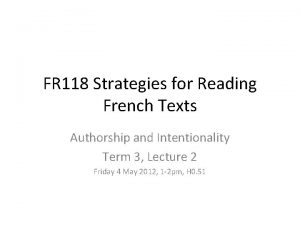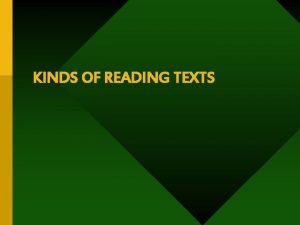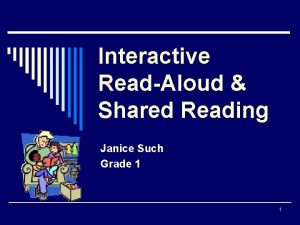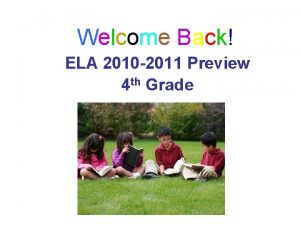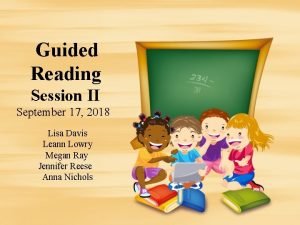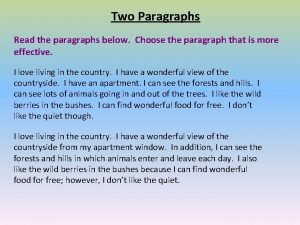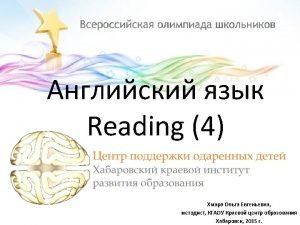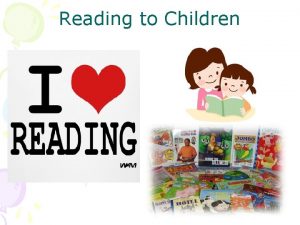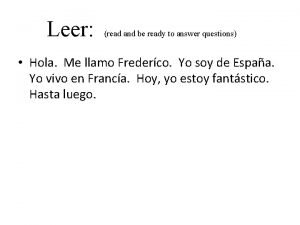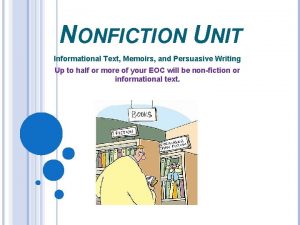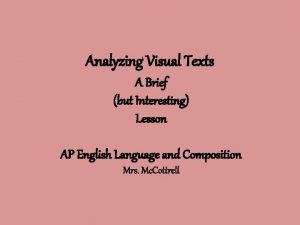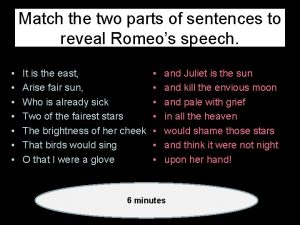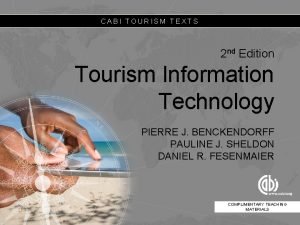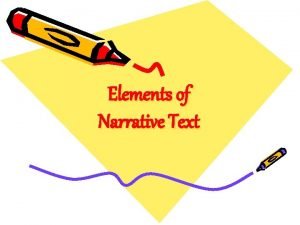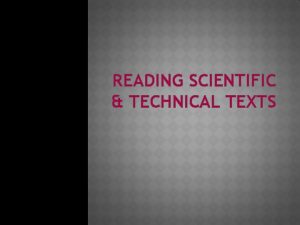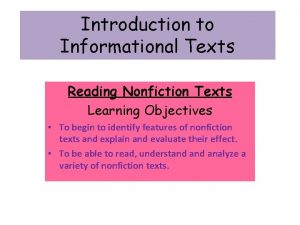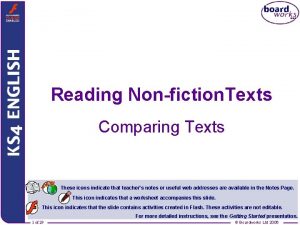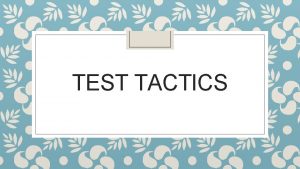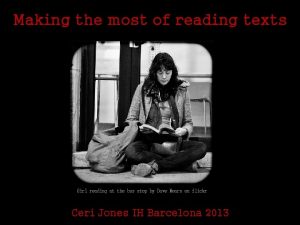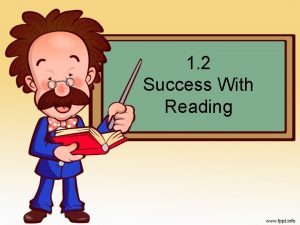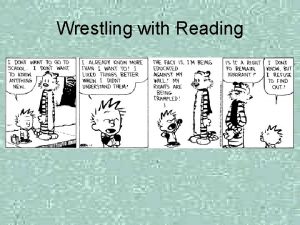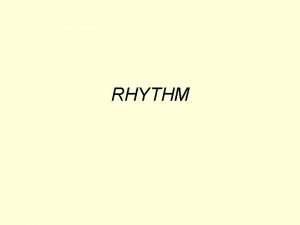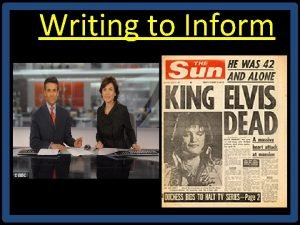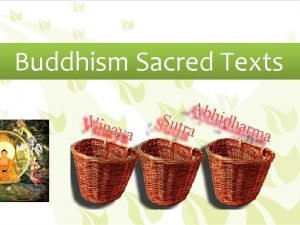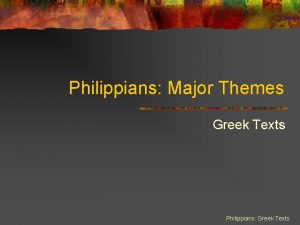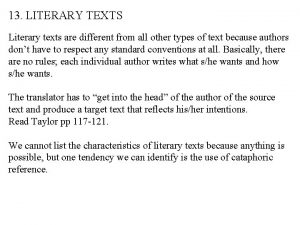KINDS OF READING TEXTS Everything we read is































- Slides: 31

KINDS OF READING TEXTS

Everything we read is either fiction or nonfiction. Fiction is writing that comes from the imagination. Non-fiction is based on facts, but can conclude opinions and arguments. Non-fiction texts can be divided into: – Descriptive – Narrative – Recount – Report – Procedure – Persuasive

Type of Reading • Scanning • Skimming • Light type of reading • Word by word.

Scanning type of reading - You are looking for it quickly. - You know what you are searching for (key words and names). - You 'see' every item on the page, but you don't necessarily read the page - you ignore anything you are not looking for.

Skimming type of reading When you read quickly to gain a general impression as to whether the text is of use to you. You are not necessarily searching for a specific item and key words. Skimming provides an 'overview' of the text. Skimming is useful to look at chapter/section headings, summaries and opening paragraphs. The purpose of skimming: To check relevance of text.

Light type of reading Reading for leisure tends to be 'light': - Read at a pace which feels comfortable. - Read with understand. - Skim the boring, irrelevant passages. An average light reading speed is 100 -200 words per minute. This form of reading does not generally require detailed concentration.

Word by word type of reading This type of reading is time consuming and demands a high level of concentration. Some material is not readily understood and so requires a slow and careful analytical read. People use this type of reading for unfamiliar words and concepts, scientific formulae. It can take up to an hour just to read a few lines of text.

Genres Narrative Purpose: To amuse/entertain the readers and to tell a story. Recount Purpose: to retell something that happened in the past and to tell a series of past event. Descriptive Purpose: to describe a particular person, place or thing in detail. Report Purpose: to presents information about something, as it is. Explanation Purpose: To explain the processes involved in the formation or working of natural or socio-cultural phenomena.

Analytical exposition Purpose: To reveal the readers that something is the important case Hortatory exposition Purpose: to persuade the readers that something should or should not be the case or be done Procedure Purpose: to help readers how to do or make something completely Discussion Purpose: to present information and opinions about issues in more one side of an issue (‘For/Pros’ and ‘Against/Cons’)

Review Purpose: to critique or evaluate an art work or event for a public audience Anecdote Purpose: to share with others an account of an unusual or amusing incident Spoof Purpose: to tell an event with a humorous twist and entertain the readers News item Purpose: to inform readers about events of the day which are considered newsworthy or important

Nasreddin’s Coat One day Nasreddin had been invited to the dinner party. He went to the party by wearing old clothes. When he arrived in the party, nobody looked at him and nobody gave him a seat. He got no food in the party so he went home and change his clothes Next he put on his best clothes. He wore his newest coat and went to the party again. The host at once got up and came to meet him. The host offered him the best table and gave him a good seat and served him the best food.

Nasreddin sat and put off his coat. He put his coat and said: “Eat the food, Coat!” The hosts and guests were very surprised and asked Nasreddin: “What are you doing? ” Nasreddin replied calmly: “When I came here with my old clothes, nobody looked at me. Then I went home and put on my best clothes. I came back in my newest coat and you all give me this best food and drink. So, you give food to my coat instead of me”. Getting Nasreddin's answer, they just shook the head.

Generic Structure Analysis Orientation: Nasreddin was invited to a dinner party Event 1: He was in the party with his old cloth Event 2: He was in the party with his best newest coat Twist: Among the hosts and guests, he asked his coat to eat the served food

Explanation – Procedure • commonly called as instruction text • commonly used to describe how to make something. • Ex : first boil water, secondly prepare the cup, and so on Explanation • a scientific written material • commonly used the passive voice • describes how certain phenomenon or event happen

Recount – Narrative Similarity : • happened in the past Difference : Recount • Describes series of events in detail Narrative • Narrative introduces crises and how to solve them.

Report – Descriptive Have the similarity in the social function and generic structure. Report • describes the way of certain things and frequently refer to phenomenon of nature, animal and scientific object. • Mostly written after getting careful observation. Descriptive • based on the objective fact of the thing. • Describe the specific thing simply as the thing is. This scientific and technical sense make clearer difference from descriptive text.

Spoof – Recount • Both of them explore the informative fact for the past experience. • Both spoof and recount focus on series of event.

Spoof – Recount • detailed information of the events. • reveals the series of events in chronological order based on time or place. Spoof • tends to project the amusement of reading. Spoof text uses tricky plot to drive readers to certain view and sooner brings the reader to the opposite point (twist).

Spoof - Anecdote Generic structure Spoof ends with twist while anecdote is accomplished by coda.

Descriptive A descriptive text describe thing, place or person and gives details about them. It usually uses the present tense. It also employs your five senses (how something feels, smells, looks, tastes and sounds).

Example : BEETLES beetles are insect. They make up one of the biggest groups of insects. There about 300, 000 kinds of beetles. They live everywhere except in the oceans. You can find beetles in the house, in the yard, in the forest, even in ponds. Like all insects, beetles have six legs. They have two pairs of wings, but they use only the back pair of wings for flying. The front wings are like tough shields. They protect the beetle’s body. Some beetles burrow underground. Some swim and dive.

Narrative A narrative text is a story and it has moral value The structure of a narrative text: 1. Orientation (beginning/introduction) : introduces main characters, setting and time. 2. Complication (middle) : the problem happens among the characters. 3. Resolution (ending) : the problem is resolved.

Example : THAT’S NOT THE WAY TO DO IT! Once there was a farmer named Hans. He wanted to sell his horse in town. One morning he started down the road with his young son and the horse. He and his son walked with the horse. They passed some boys. “That’s not the way to do it!” said a boy. “Why is that man walking? He has a horse!” “He’s right, ” said Hans. He got on the horse and his son walked behind him. Then they saw some women. “Look at the man!” said a woman. “He’s on the horse and his poor boy is walking. ” “She’s right, ” said Hans. He got down and put his son on the horse. They walked some more. “Isn’t that terrible!” said an old man. “Young people have no love for their parents these days! Look at that boy on the horse. His poor father is walking. ” “He’s right, ” says Hans. He got on the horse behind his son. Then they saw some girls. “Two people on a horse!” said the girls. “The poor animal. ” “They’re right, ” said Hans. He and his son got off the horse. They put the horse on their backs and carried it down the road. They came to a river with a bridge. Some people were fishing from the bridge. “Look at that!” they said. “Look at the horse!” They laughed and laughed. The horse didn’t like this. He move and kicked. “Help, help, ” cried Hans. And they all fell off the bridge and into the river – Hans, his son, and the horse. The horse ran home. Hans and his son climbed out of the river. “Next time, ” said Hans, “I’m not going to listen to other people. I’m going to do it my way. ”

Recount A recount text tells a past experience of someone in a chronological order, contains facts. It uses simple past tense. The structure of a recount text: 1. The orientation : tells who was involved in the story, when, where, and why the story happened. 2. Series of events : tell what are going on in the story. 3. The re-orientation : concludes the story.

Example : WHAT I DID ON SATURDAY I went to the swimming pool on Saturday with my grandma and granddad. Grandma bought me a new swimming costume as a treat and I wanted to wear it. First of all I went in the changing rooms with grandma and got changed. You have to put your clothes in a little locker and then you put 10 p in so you can lock it. I had to put the key on a band round my ankle. next we want into the water. Granddad sat on the side to watch us but grandma and I went down the steps into the water. It was very cold and grandma made me jump up and down to get warm. If I wear my arm bands I can nearly swim a width. Grandma can’t swim at all. Then I got dressed and grandma and granddad bought me a coke and a bag of chips. It was nice because you could sit and eat and watch the swimmers at the same time. I learned the way to do the arm and leg movements for breast stroke. I’m going to lay on my bed and practice this every day. Next time I go to the pool I might be able to swim.

Report A report text is written (or spoken) description of what you have seen, heard, done, etc. it consists of : 1. A general classification which introduces you to the subject discussion in the passage. (It begins with a topic sentence). 2. A description which describes the main subject or elaborate the topic sentence.

Example : THE HISTORY OF NEWSPAPERS Printing machines were invented in 1450. Before that, news was spread verbally or in written letters. In the past, people of Rome had a good way for circulating written news. Their first written news was called Acta Dluma or daily events. It was posted by the government in the public places. In the past, the government of China produced news sheet, called Tipao. It was only circulated among court officials during the Han dynasty. At some point during the Tang dynasty, carved wooden blocks were used to print Tipao. It was the first printed newspapers in history.

Procedure A procedure text tells you how to do something. The language used is direct and unnecessary words are left. It often uses must and mustn’t.

Example : HOW TO MAKE ICED COFFEE There are some steps to make delicious iced coffee. First, brew a pot of fresh coffee. If you are making the coffee just to be iced, prepare a slightly stronger blend than usual to account for ice melting later. Second, transfer the desired amount to a carafe or pitcher. Third, let stand at room temperature for three or five hours, or refrigerate for 11/2 to three hours. Fourth, fill a ten to twelve oz. glass with ice cubes. And then, pour the chilled coffee into the glass. And finally, stir the coffee to equalize its temperature. Add milk if you like.

Persuasive A persuasive text tries to change the reader’s minds. Some texts are aimed at trying to persuade the reader to do something (such as give money to a certain charity, buy a certain car).

Example : Dear friend, Are you tired of the daily grind? Sick of working all hours of the day for little reward? Tired of never having enough money to really enjoy yourself? Well, now there’s a way out… We can show you the way to give up work, sit back and make millions for yourself and your loved ones on the property market. Albert Smith felt just like you until he read our leaflet. Now he drives a sports car around the south of France, and his wife has one of her own too!
 That's a little proud beige british bulldog
That's a little proud beige british bulldog Read the advertisement below
Read the advertisement below Read the text below and complete the task.
Read the text below and complete the task. Read the text below and
Read the text below and While reading activities
While reading activities Mentor texts for reading workshop
Mentor texts for reading workshop Fr 118
Fr 118 Kinds of reading text
Kinds of reading text Difference between silent reading and reading aloud
Difference between silent reading and reading aloud Interactive read aloud definition
Interactive read aloud definition Shared reading vs read aloud
Shared reading vs read aloud Shared reading vs read aloud
Shared reading vs read aloud The paragraphs below
The paragraphs below Read the text and answer the questions below.
Read the text and answer the questions below. Balanced literacy definition
Balanced literacy definition Shared reading vs read aloud
Shared reading vs read aloud Reading read and answer the questions en español
Reading read and answer the questions en español Critical reading active process of discovery
Critical reading active process of discovery St. louis
St. louis Real definition of extensive reading
Real definition of extensive reading Reading aims
Reading aims Intensive reading and extensive reading
Intensive reading and extensive reading Definition of guided reading
Definition of guided reading Types of reading skill
Types of reading skill Persuasive nonfiction
Persuasive nonfiction Analyzing visual texts
Analyzing visual texts Examples of transactional text
Examples of transactional text Reported speech
Reported speech Match the two parts of the sentences
Match the two parts of the sentences Cabi tourism texts
Cabi tourism texts Parts of a narrative
Parts of a narrative Expository text mean
Expository text mean

